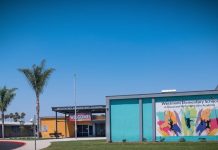By Loreen Berlin
Westminster High School is celebrating.
First off, there was the harvesting of 150,000 pounds of watermelons last week at the school’s farm.
Then, “The Giving Farm” at the high school just received a $100,000 USDA grant.
The grant funds will be used for additional farm equipment and supplies, a farm aid, integration of some farm food into school meals and food and nutrition education for low-income students and their families, said OC Food Bank Director Mark Lowry, with Community Action Partnership of Orange County.
“This is a real working farm that’s organic, with the harvest being donated to a charity,” said agricultural teacher Dave Eusantos, who mentioned a few of the other foods grown on the farm, including avocados, pomegranates and lemons, “That assist families in food-service need.”
The watermelons and other crops at the farm are donated to the OC Food Bank, teaching students in the Future Farmers of America (FFA) program about food production and giving back to the community.
A fun side-light is that the cows on site, a Jersey and Holstein and their calves, also enjoy the rinds of the watermelons.
Students attending the school, took rotations in classes to hand-carry all of the watermelons in from the growing fields, to be placed in large packing boxes for transportation to the Orange County Food Bank.
Although there are approximately eight FFA programs throughout Orange County, Westminster High School’s “The Giving Farm” can boast of being the largest, with 8 acres of growing area. It’s a learning experience to know where food actually comes from for the youth, coupled with learning to give to others.
Originally, the FFA program had 150-enrolled students but that has now grown to 300 students.
In addition to the horizontal growing fields, students are being taught “Vertical” growing in a tower-system, so that even apartment dwellers can grow and harvest their own food in a “progressive agricultural” manner.
“We have to be creative in farming,” said Lowry.
FFA Advisor Nathan Kesser noted that the large yellow plastic barrels are for collecting the watermelon rinds.
“Nothing is wasted; the cows get vitamins and nutrients from the rinds,” he said. “Today, it’s the goal of having all 2,700 students take part in the harvesting, from freshmen, seniors, juniors and sophomores.”
Kesser said that he went into agriculture because his agriculture teacher had a big influence on him.
There’s a lot of history in the 8 acres of land, which equals approximately eight football fields, and it continues today to create future agriculturalists.










